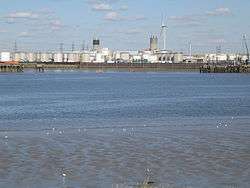Barking Power Station
| Barking Power Station | |
|---|---|
 Barking Reach Power Station Viewed from the south in October 2007 | |
| Country | England |
| Location | Greater London |
| Coordinates | 51°31′16″N 0°08′49″E / 51.5210°N 0.1470°ECoordinates: 51°31′16″N 0°08′49″E / 51.5210°N 0.1470°E |
| Commission date | 1897 |
| Operator(s) |
Barking Town Urban District Council (1897-1927) County of London Electric Supply Company (1925-1948) British Electricity Authority (1948-1955) Central Electricity Authority (1955-1957) Central Electricity Generating Board (1957-1981) Thames Power Services (1995-present) |
| Thermal power station | |
| Primary fuel | Natural gas |
| Tertiary fuel | Coal |
| Power generation | |
| Nameplate capacity | 220 MW & 144 MW |
| grid reference TQ4893882469 | |
Barking Power Station refers to a series of power stations at former and current sites within the London Borough of Barking and Dagenham in east London. The original power station site, of the coal-fired A, B and C stations, was at River Road, Creekmouth, on the north bank of the River Thames. These stations were decommissioned by the end of the 1980s and have since been demolished. The current gas-fired power station (originally generally known as Barking Reach Power Station) was built further down the Thames near Dagenham Dock in the early 1990s. The site of the former power stations is being redeveloped as Barking Riverside.
History
Barking A power station
Prior to the construction of Barking A Power Station, Barking Town Urban District Council operated its own small power station near its offices from 1897 until its closure in 1927.[1] In 1920, the County of London Electric Supply Company applied for permission to build a power station at Creekmouth in Barking capable of expansion to 600 MW.[2] The Barking A Station had 8 C. A. Parsons turbo-generators (4 x 40 MW and 4 X 20 MW) and 22 boilers, plus 2 dedicated reheat boilers. These were in two boiler houses, one being all chain grate boilers (6 B&W and 6 Yarrow) and the other being all pulverised fuel boilers (I.C.L.). Barking Power Station opened in 1925, and in 1927 it took over from the Barking Town Urban District Council station, providing a bulk electricity supply.[1]When completed, the A station was the largest power station in Britain to have been built as a complete station at one time. The Yarrow boilers were scrapped in the early 1950s, their capacity being replaced by steam from the B station via a steam line and suitable regulating equipment. The pulverised fuel boilers were converted to oil firing around 1964.
The site of the power station was chosen for easy delivery of coal from the Thames and by rail, as well as the abundant water supply and space on the site for expansion.[1] A cable tunnel was constructed under the river to supply the south bank with electricity.[3]
Barking B power station
Barking's original A station was extended by the building of the B station, which began to operate at full capacity in 1939. The capacity of the B Station was 303 MW with 4 x 75 MW B.T.H. turbo-generators plus a small house generator of 3.5 MW capacity. Steam conditions were 600 psig and 800'F. The B Station had 16 B&W chain grate boilers, each capable of producing 256,000 lbs steam per hour. These were arranged in two boiler houses, with 8 boilers in each. The power station was transferred to the London Division of the British Electricity Authority in 1948.[1] The B station closed on 15 March 1976, at which time its generating capacity was 144 megawatts.[4]
Barking C power station
The British Electricity Authority built a third station at Creekmouth, which was completed in 1954. The station was closed on 26 October 1981, at which time its generating capacity was 220 MW.[4] All three stations have since been demolished. The C Station had three B.T.H. 75 MW turbo-generators operating with steam conditions of 900 psig and 900'F. There were 6 B&W boilers, 5 being pulverised fuel and the sixth a cyclone furnace. The pulverised fuel boilers were converted to oil firing around 1960.
Barking Reach power station
The current station is at Chequers Lane in Dagenham, to the west of Dagenham Breach (pond) and the Ford motor works. The station was constructed between 1992 and 1995 and was the first major generating station to be built in London for many years. It is one of the largest independently owned generating plants in the UK, being capable of generating 1000 MW of electricity, which is about 2% of the peak electricity demand in England and Wales.
The station uses Combined Cycle Gas Turbine technology, with gas as its primary fuel. The station is owned by Barking Power Limited but is operated and managed by Thames Power Services.[5] Unlike the Creekmouth stations, the Dagenham station is some distance from the river.
In July 2014 the operators announced their intention to close the power station within two years. as of 2018 demolition of the power station has started.[6]
References
- 1 2 3 4 "'The borough of Barking'". A History of the County of Essex: Volume 5 (1966), pp. 235-248. Victoria County History. Retrieved 2007-12-05.
- ↑ Mr. Holmes (4 November 1920). "ELECTRIC POWER SCHEMES, LONDON". Hansard. Retrieved 3 September 2009.
- ↑ Smith, D (2001). Civil Engineering Heritage: London and the Thames Valley. Thomas Telford. ISBN 0-7277-2876-8.
- 1 2 Mr. Redmond (16 January 1984). "Coal-fired Power Stations". Hansard. Retrieved 1 September 2009.
- ↑ "Barking Power Station". Barking Power. Retrieved 2008-03-08.
- ↑ "Barking Power Station in east London to close within two years". Reuters. 29 July 2014.
| Wikimedia Commons has media related to Barking Power Station. |
| Preceded by Carville B Power Station |
Largest Power Station in the UK 1925 |
Succeeded by Agecroft Power Station |
| Preceded by Fulham Power Station |
Largest Power Station in the UK 1954-1962 |
Succeeded by Drakelow Power Station |
